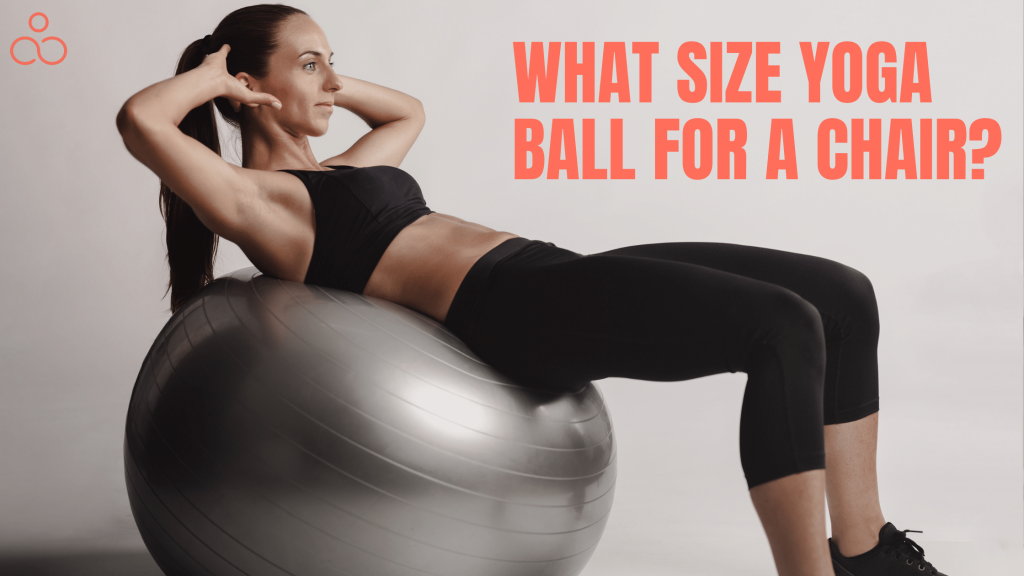Whether you’re looking for a relaxing spinal release or a rigorous ab workout, a Yoga ball is a perfect tool for strengthening core muscles, Pilates, strengthening exercises, posture correction, and deep stretching.
However, it could be challenging to sort through all the sizes and options available in the market when trying to decide “what size Yoga ball to get for a chair”; “what size Yoga ball for office chair will be an ideal choice for you”; or “what features to look for while investing in a Yoga ball”. You don’t want something too big to sit on or stretch out on comfortably, or that will collapse beneath your weight.
To find answers to these questions, let’s first learn more about Yoga balls and their useful related topics. This article will help you choose the proper size Yoga ball for your chair, home workouts, and post-Yoga stretchings.
What is a Yoga ball? What size Yoga ball for a chair is a perfect purchase?
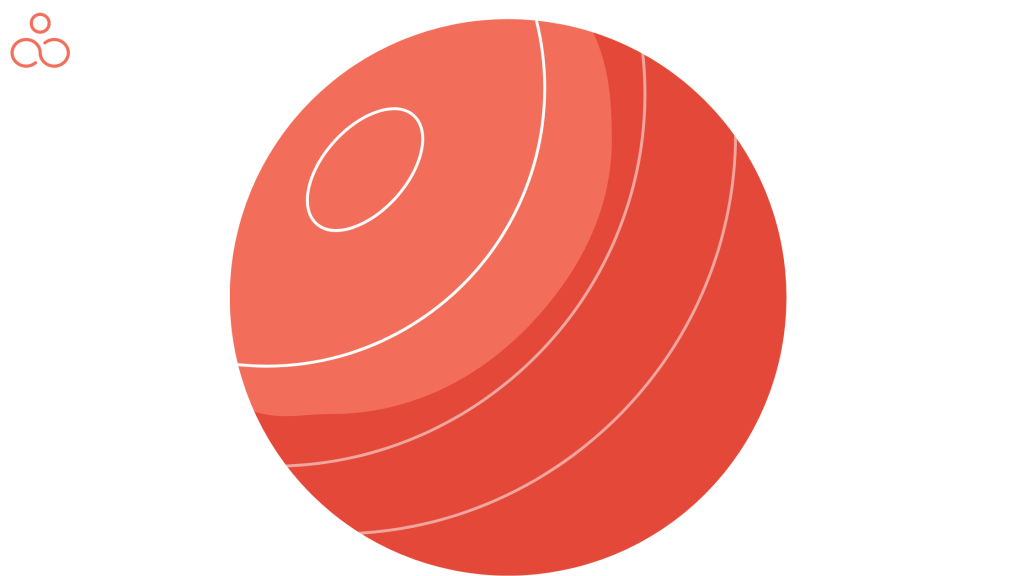
Also known as a balance ball, Swiss ball, exercise ball, or fitness ball. Yoga balls are soft plastic exercises for core strengthening, physical therapy, and weight training.
Depending on the size of the ball and the air pressure applied, exercise balls can help you gain more stability and muscular tone. The irregular surface activates your microfiber muscles and core muscles.
Selecting the proper ball size for an effective Swiss ball workout is essential. Exercise balls are priced according to their diameter when completely inflated. “Standard size” doesn’t exist. The proper size is determined by your height and how you want to use the ball.
Exercise Ball Size Chart
For convenience, refer to the chart below to select the accurate Yoga ball size based on height.
| Height of the Person | Exercise Ball Diameter |
| 5′ and under | XTRA SMALL 45 cm (17 inches) |
| 5’1″ – 5’8″ | SMALL 55 cm (22 inches) |
| 5’9″ – 6’2″ | MEDIUM 65 cm (26 inches) |
| 6’3″ – 6’7″ | LARGE 75 cm (30 inches) |
| 6’8″ and taller | XTRA LARGE 85 cm (35 inches) |
Although the chart above is for general exercise, picking the correct ball size for an office chair is slightly different. It is strongly advised to use an exercise ball one size larger when sitting at a desk. This is because sitting on the ball will cause it to deflate slightly.
A guide on how to measure your ideal size Yoga Ball
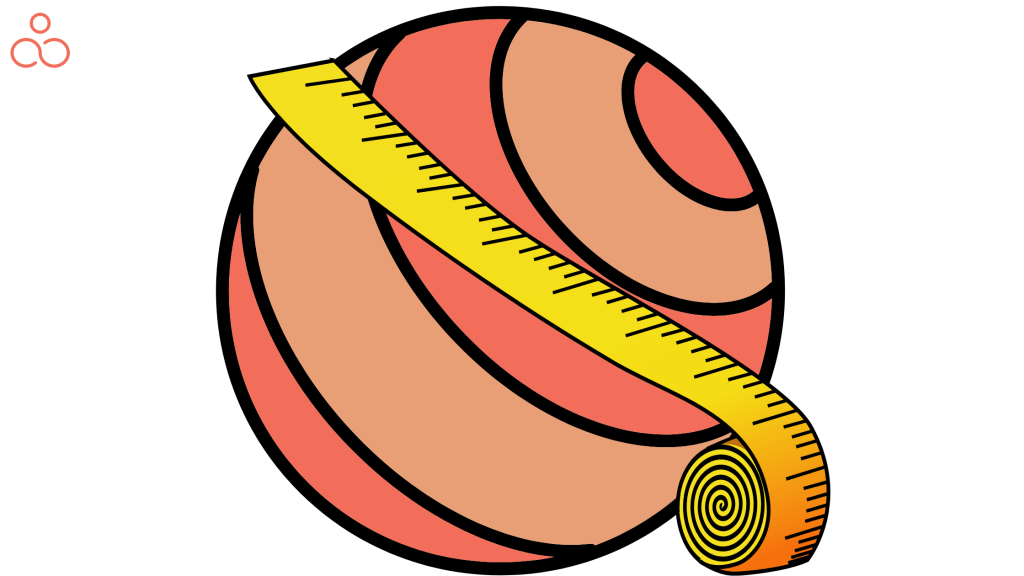
An exercise ball with the right size is essential for active sitting and for supporting your body. Place your feet resting flat on the floor, your knees angled at 90 degrees, and your thighs equal to the ground. This is the ideal seating position.
Use your height to determine the appropriate size Yoga ball, or sit against a wall and measure the size of the ball, then mark the spot where the ball should ideally land beneath you.
Steps to do it
- Make sure to stand with your back against a wall.
- Your hips and knees should form a precise 90-degree angle as you sit down against a wall.
- Make a mark with a pencil on the wall directly below your tailbone.
- Measure the distance between the floor and your pencil mark using a tape measure. The ball should be at this height for you.
*Note: Keep in mind that the ball will naturally compress downward when you sit or lie on it. To guarantee proper proportions, measure up if you need clarification on your size or if your ball is deflated.
How inflated should your Yoga ball be for an ideal desk chair?
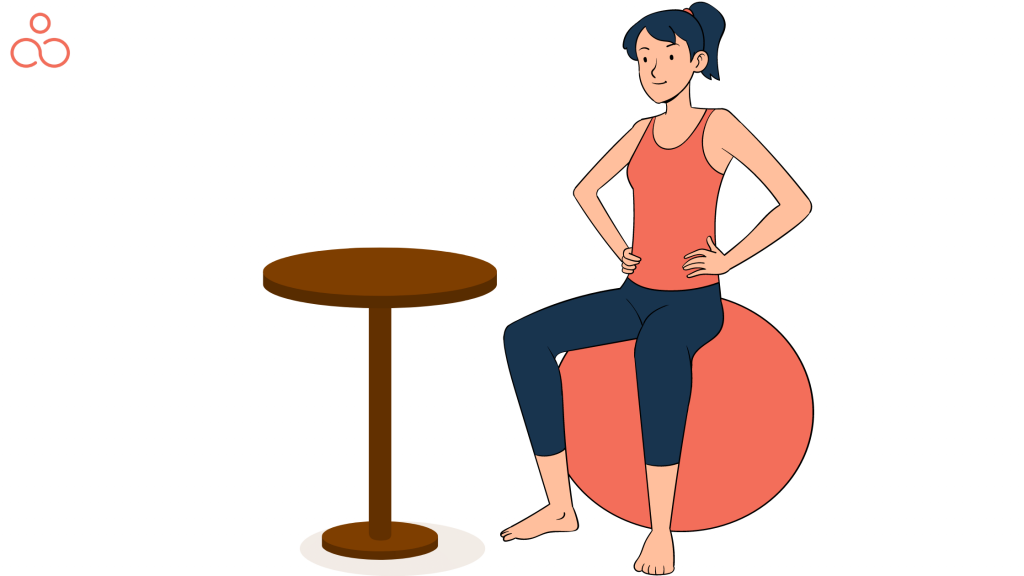
When you sit on an exercise ball, it should be inflated enough that it decompresses a few inches. You don’t want to overfill your workout ball and turn it into a rock.
Fill the workout ball to 80 per cent capacity on the first fill. The chart below shows how tall your workout ball will sit during the initial air-fill stage.
| Exercise Ball Diameter | Recommended Initial Fill |
| 85 cm | 68 cm (27 in) |
| 75 cm | 60 cm (24 in) |
| 65 cm | 52 cm (21 in) |
| 55 cm | 44 cm (18 in) |
Watch this YouTube Video to visualize how much air you can fill your exercise ball.
Different ways to use a Yoga ball for your daily fitness routine
A Yoga ball can be used for:
1. Yoga and stretching
A stability ball can be a great Yoga prop to help you deepen your stretches without the risk of strain. It can also be used in more intricate poses, like the Scorpion pose, adding weight and balance to workouts. These inflatable balls are versatile – they can adjust any posture to make it easier or more difficult. Yoga balls are ideal for those looking to up their game in balance, core strength, and flexibility.
2. Strength training
An exercise ball in body weight or dumbbell exercises can help you give a comprehensive full-body workout. Instead of just focusing on the arms with particular moves like the pectoral fly or “skull crusher” tricep dip, you can also target muscles in your legs and core. The inflatable ball operates like a workout bench but with a bit more flexibility, as it takes effort from those tiny muscle fibers to keep your body stable while sitting or lying on it.
3. Core workouts
An exercise ball is perfect for core-strengthening exercises. With the right size stability ball, you can use it to support your back or legs while ensuring every part of your abs and obliques are being worked, which you will feel and may even cause shaking as you attempt to remain balanced.
4. Desk chair replacement
You can replace your desk chair with an inflatable exercise ball for improved posture and a light core workout while working at the computer. Choosing one of the correct sizes will ensure that you can sit evenly and comfortably with your feet on the ground and your back in a straight line.
An Extra Useful Guide on Yoga Ball for Pregnant Women
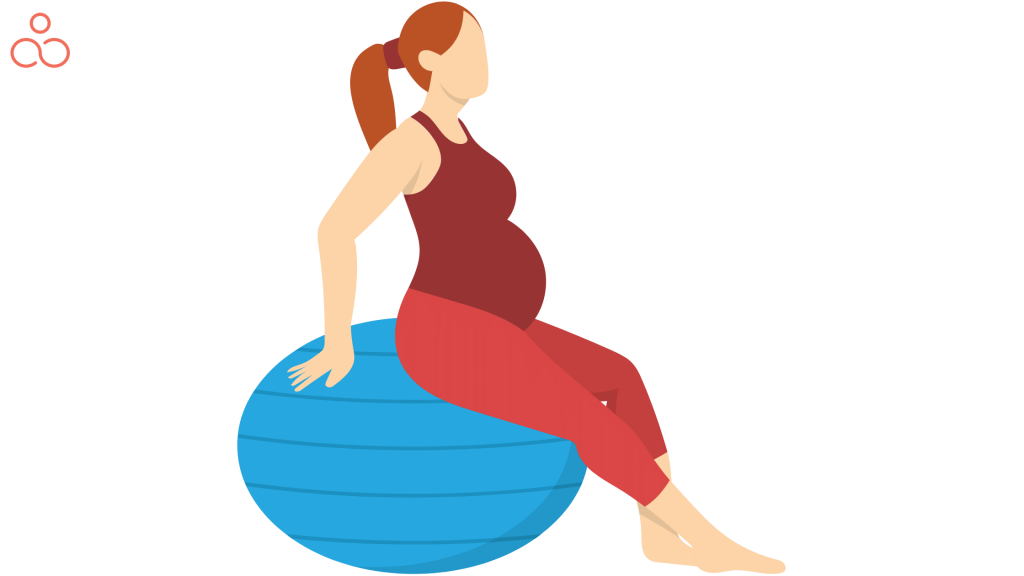
This is a practical manual for all mothers and mothers-to-be. Even during pregnancy, you should continue to work on strengthening your core. A Yoga ball might help relieve your pelvis and lower back strain.
- Consult your doctor before beginning any fitness regimen while pregnant.
- Remember that your exercise routine may fluctuate throughout pregnancy due to morning sickness, low energy, or overall discomfort.
- We caution patients against using the exercise ball for any activities that make them unstable and increase their risk of falling, such as sitting without both feet on the ground.
- Avoid workouts that require lying on your back since doing so might lower your blood pressure.
Following are some excellent Yoga ball workouts you should attempt if your doctor has given you the go-ahead to exercise while pregnant:
- Wall Squat
- Ball March
- Pelvic Floor Exercises
- Ab Crunch
- Back and Upper Body Stretch
- Kneeling Ball Roll-Outs
- Ball Bridges
- Ball Circles
- Figure-8
Exercise balls can be used as birthing balls and a beneficial element of pregnancy-safe workouts. While pregnant, sitting on the right exercise ball may help open up the pelvis and pelvic floor.
The Advantages of Sitting on a Yoga for your body
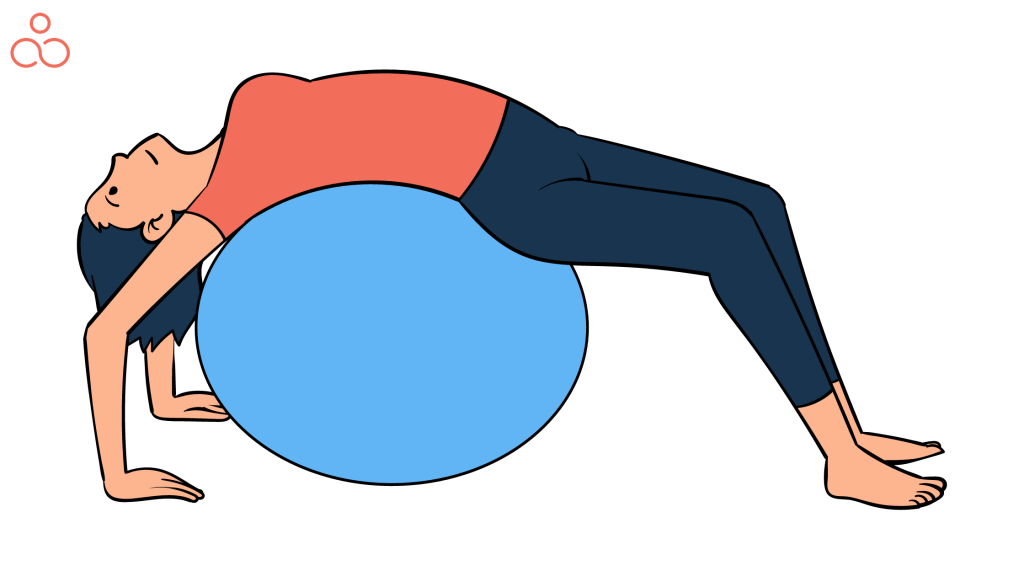
1. Core Strengthening
Sitting on an exercise ball helps to develop your stability and balance, as you must use your core abdominal muscles to stay upright. This strengthens the core, protects the lower back, and encourages good posture.
2. Increase in Calorie Burn
According to the University of New Hampshire researchers, sitting on a ball slightly boosts the number of calories you burn daily.
3. Improvement in Balance and Mobility
According to the American Council on Exercise, Yoga balls can assist in building stability and mobility when used during a workout. This type of integral fitness is vital to establishing a solid base for upcoming exercises.
The Disadvantages of Sitting on a Yoga Ball All Day
Prolonged sitting has been associated with severe health concerns in the long run, such as diabetes, obesity and heart illnesses. Additionally, continuous sitting can cause one’s muscles, mainly in the hip flexors area, to become tense, which can have an adverse effect on balance, posture and even gait. However, using stability balls to replace desk chairs is not necessarily the most practical option.
1. May Cause Aches and Pains
Sitting on a stability ball requires the active engagement of the core muscles due to the lack of support from a backrest. When used correctly, this posture can lead to improved posture and core strength; however, aches and pains may follow when one relaxes in this position. Lower backaches are common if proper technique is not employed, as well as discomfort in the wrists and shoulders due to the absence of armrests. Exercise caution when using an exercise ball for those with back pain, as incorrect techniques can worsen symptoms.
2. Can Lead to Muscle Tightness
If you want to reduce the chances of experiencing hip flexor and hamstring tightness, sitting on a stability ball may not be enough; you may need to take further steps to combat the adverse effects of sitting for extended periods.
3. Lack of Support
Regarding desk seating, an ergonomic office chair is superior to an exercise ball. It surpasses a fitness ball with the ability to adjust the seat’s depth and angle and provide lumbar and armrest support.
FAQ’s
How Should I Use an Exercise Ball to Sit at the Desk?
- You should replace your desk chair with an exercise ball. Make sure your hips, legs, and knees are correctly aligned by positioning your feet flat on the floor with both legs in front.
- It is best to refrain from crossing your legs or extending them to the sides as this can disturb your spine’s alignment, leading to back or hip discomfort.
- Sit upright on the ball, ensuring the correct muscles in your core are activated. Your shoulders should feel loose, and your arms should be in front of you.
How long should I sit on an exercise ball at work?
- The time one spends sitting on a stability ball during work differs from person to person, based on their core strength and comfort level.
- People should limit their time sitting on an exercise ball to two hours. For optimum health and fitness benefits, 20 minutes is optimal, though at most two hours.
- Having shorter time frames is more appropriate and healthier for your body – as prolonged engagement of your core muscles can eventually lead to your spine becoming misaligned, damaging your back.
Is It Possible to Lose Weight by Sitting on an Exercise Ball?
No, simply sitting on an exercise ball won’t do much to help you lose weight. It won’t burn calories despite engaging and strengthening your core muscles more than sitting in a chair. To burn up to 50 calories, you’d have to bounce on the ball for an hour straight – however, this may still not be enough for significant weight loss.
Is it healthy to use an exercise ball for sitting at the office?
Using a balance ball as an office chair has its advantages, including burning four calories per hour, but generally, it’s less comfortable than a traditional chair. Consider factors such as desk height to determine if the ball is right for you. Despite the potential benefit of sitting on the ball, most users need more comfort than regular office chairs.
Does using an exercise ball while sitting relieve sciatica?
Regarding sciatica, sitting on an exercise ball is not recommended. With the balls being unstable, finding proper balance can be difficult because of the need for back support. Additionally, there have been reports of increased pain in the lower back region from those initially trying this method. Learning how to sit correctly to manage sciatica and achieve comfort when sitting for long periods at work is essential.
Recommended Tips:
- It is essential to understand your fitness level and begin Yoga ball workouts at a reasonable degree. Acclimate yourself with the ball; hold onto something stable, such as a chair or the wall, when you start so you don’t roll backwards or sideways and tumble off.
- Most balls sold as fitness equipment are made of the best quality materials and come with an inflation pump. Look for burst or puncture-resistant balls that deflate slowly if a hole develops – sometimes labeled SDS (slow deflate system).
- Exercise balls are usually measured in metric diameters, so it’s crucial to figure out the size of your desk chair in centimeters and inches.
- An excellent ergonomic chair is often preferable to an exercise ball for posture and pain relief, but the latter is still preferable to most chairs.
Warnings!!!
- Avoid excessive bouncing or playing with the ball to prevent injuries from falling off, significantly diminishing its usefulness.
- If you have a history of back discomfort, it is important to consult your doctor or physical therapist before engaging in exercise ball training. Ask them to demonstrate the proper use of the ball and to provide guidance on whether it may help or aggravate your condition. If the ball causes any pain, finding an alternate, pain-free exercise method is crucial.
Conclusion
Yoga balls are inexpensive additions to your routine, whether you desire a Yoga ball to enhance your practice or obtain spinal relief while you work.
You now have a simple guide to the topic of “what size Yoga ball for a desk chair will be an ideal choice for your fitness routine?” Selecting the proper size is crucial to both your comfort and avoiding accidents. If you test it out, remember to get one from a reliable company.
In all honesty, we don’t see any benefits to utilizing a Yoga ball as a chair for the workplace. Choosing the perfect ergonomic office chair is advisable if obtaining the proper sitting posture is your main priority. Nowadays, most options are reasonably priced and include elements that can improve your posture.
However, if you insist on using an exercise ball, always turn to the exercise ball size chart for guidance. More importantly, remember to stay active and regularly move to help fight the adverse effects of a sedentary lifestyle. We hope you find health and fulfillment wherever you are.

